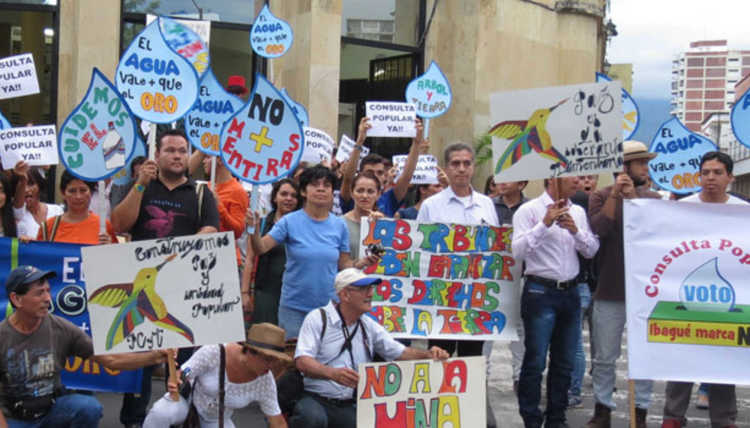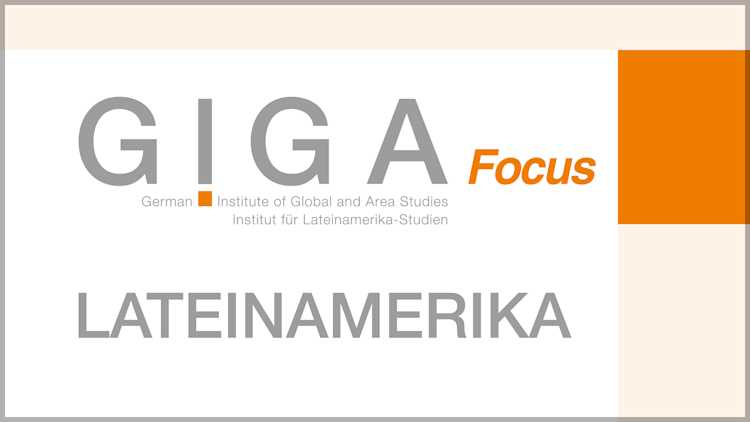- Home
- Publications
- GIGA Focus
- Environmental Democratisation in Post-War Colombia
GIGA Focus Latin America
Environmental Democratisation in Post-War Colombia
Number 5 | 2016 | ISSN: 1862-3573
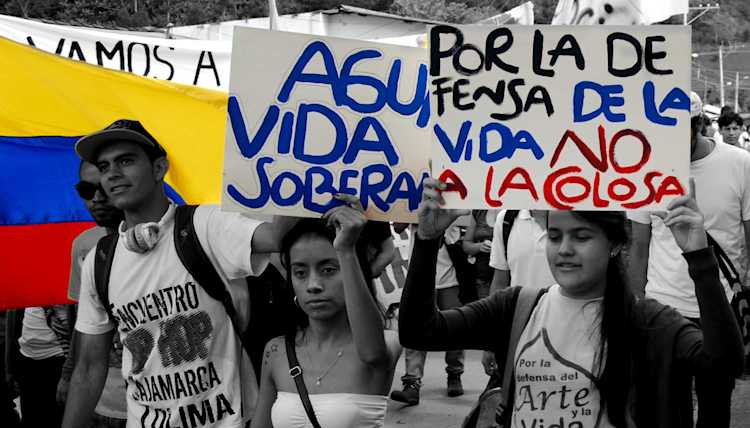
In 2004 a social movement for environmental democratisation began in Colombia in response to the exponential expansion of extractive activities and socio-environmental conflicts driven by policies designed to transform Colombia into a mining country. The state’s reaction to this mobilisation has been ambiguous, as it depends on the rents of extractive frontiers but is also the guarantor of the Constitution and of the rights of its citizens.
Colombia is entering a new era in 2016 by signing a peace agreement with the FARC rebel movement. After 50 years of violence and millions of people killed or displaced, this is an opportunity to end today’s “longest civil war” worldwide.
However, the need to generate revenue to fund the post-war reparation, restitution, and reintegration programmes and, more generally, to fulfil the demands of global markets for minerals, energy, food, and materials puts great pressure on the rural areas where the violent conflict has concentrated.
The presence of extractive industries in rural areas of peasant economies and ethnic territories has exacerbated previously existing territorial conflicts largely driven by land use. Colombia reports the second-largest number of socio-environmental conflicts in the global Environmental Justice Atlas, and it ranks second in Latin America and third worldwide in the number of assassinations of environmental and land activists.
The activation of several democratic-participation mechanisms incorporated into the Colombian Constitution of 1991 for environmental issues demonstrates the aspiration of marginalised groups to participate in the decision-making process regarding territorial planning, the use of resources, and the economic model, which all greatly influence socio-environmental conditions.
Policy Implications
Encouraging environmental democratisation is indispensable for achieving environmental justice and a transition to peace in Colombia. The international community could support this process by promoting higher standards, accountability, and participation in environmental decision making; by bolstering the Colombian state in its effort to redesign its revenue system from extractive industries to discourage highly destructive activities; and by promoting the small-scale, sustainable, rural economies that are at the core of the peace agreement.
Colombia in Transition to Environmental Peace?
The year 2016 marks a new beginning in the history of Colombia, as the government signed an agreement with the FARC to end a period of more than 50 years of hostilities. However, the end of the armed conflict could also exacerbate socio-environmental conflicts that have characterised the long history of extractive activities. The government relies on the extractive sector to finance the expensive process of transitioning to peace. Even before the peace process, the former government of Alvaro Uribe (2002–2010) had granted large concessions to private investors for oil and mineral exploration and extraction. Additionally, an increasing global demand for resources and the belief of private investors that they will have easier access to areas previously under the control of FARC are boosting further extraction. Marginalised communities in rural areas that have been severely affected by the armed conflict have cautious expectations about the development model to be implemented in their territories in the post-war era.
Since 2004 communities affected by the arrival of extractive industries have activated several mechanisms of democratic participation that were incorporated into the Colombian Constitution of 1991. These mechanisms include the referendum, the normative initiative, the popular consultation, and the open hearing (cabildo abierto). The mechanisms have been called upon in order to protect water sources and local economies and to debate alternative visions to extractivism. Communities want to participate in a meaningful and consequential way in decision making about the use of local resources in activities with the potential to impact their livelihoods and their environment.
Social Metabolism and Extractive Frontiers
Two concepts can help elucidate the relationship between socio-environmental conflicts and the economy. The first, social metabolism, links economic processes to the consumption, depletion, and appropriation of natural resources. It refers to the manner in which human societies organise their growing exchanges of energy and materials with the environment (Martinez-Alier 2009). It describes the scale and rates of use of resources both for consumptive use and for sinks into which waste resulting from transformation processes is deposited. Globally changing patterns of consumption and production, the search for profits of global capital, and a five-fold increase in the human population since 1900 have increased social metabolism at unprecedented rates (Martínez-Alier et al. 2010). This trend is exacerbating the pressure to extract resources from peripheral regions such as Africa and Latin America, which has significant socio-economic and environmental implications for these regions (Muradian, Walter, and Martinez-Alier 2012). Colombia has seen a significant rise in the amount of materials exported since 1985 in comparison with the materials it has imported. The export of oil, coal, ferronickel, gold, biofuels, and other materials exceeds imports by a factor of no less than three (Pérez-Rincón 2014). Despite the great physical-trade imbalance, Colombia and other countries in the region are not able to pay for their imports. The commercial deficit further intensifies the social metabolism as commercial deficits have to be compensated for by further extraction, foreign investments, or bank loans, which in due course will produce repayments to foreign countries.
This brings us to the second useful concept, the “commodities frontier” (Moore 2015). Commodities or extractive frontiers are the territories on which capitalism depends as the providers of resources (food, raw materials, energy, and labour) to be transformed and commoditised. The capitalist system has always depended on a less-developed exterior, or frontiers, to supply these goods and services. As Moore explains, since the sixteenth century there have been world movements of appropriation from frontier zones of low or minimal commodification. The intensification of the social metabolism implies the expansion of extractive frontiers to new territories. The economy of rich countries or regions is so dependent on inputs of energy and materials that, even without economic growth, the pressure is bound to rise on the extractive frontiers from which these inputs derive (Martínez-Alier et al. 2010). The continuous expansion of extractive frontiers is leading towards the exhaustion of cheap resources and moving into territories that are ecologically vulnerable and inhabited by indigenous people or disadvantaged social groups, thereby setting the conditions for the emergence of new conflicts over resource extraction (Muradian et al. 2012; Martínez-Alier and Walter 2016). Local inhabitants increasingly resist extraction because of the more severe environmental impacts that are exacerbated by the decline in the quality of mineral reserves, the need to access fuels through unconventional methods of unknown impacts such as fracking, and the violence involved in the appropriation of resources for all kinds of extraction. These growing socio-ecological tensions are gaining geopolitical and geo-economic significance. It could be said that one distinct feature of the current crisis of capitalism is that the extractive frontiers on which the global economy has historically depended are becoming smaller, more costly, and more problematic.
Socio-environmental Conflicts and Violence in Colombia
In this context, it is not surprising that the world is experiencing an increase in environment-related conflicts, particularly in regions with ecologically vulnerable ecosystems, an intensive human occupation of territory, and high levels of social organisation. With 121 cases, Colombia reports the second-largest number of socio-environmental conflicts in the Environmental Justice Atlas, as shown in Figure 1, and it is ranked third globally, after Brazil and the Philippines, on the list of countries with the largest number of assassinations of environmental activists (Global Witness, 2016). The database on social struggles from the Centro de Investigación y Educación Popular (CINEP) for the period from 2001 to 2011 registered 274 collective social actions associated with oil, coal, and gold extraction, a notable increase since 2005 (CINEP 2012). Based on the cases reported in the Environmental Justice Atlas (EJATLAS 2016), Pérez-Rincón (2014) shows that up to 2001 there had been 19 visible environmental conflicts in the country. From 2002 to 2010, corresponding to Alvaro Uribe’s two terms in office, 47 conflicts began. During the first Santos government, six additional conflicts were reported. Of the 72 conflicts, 61 per cent were related to mining or fossil energy.
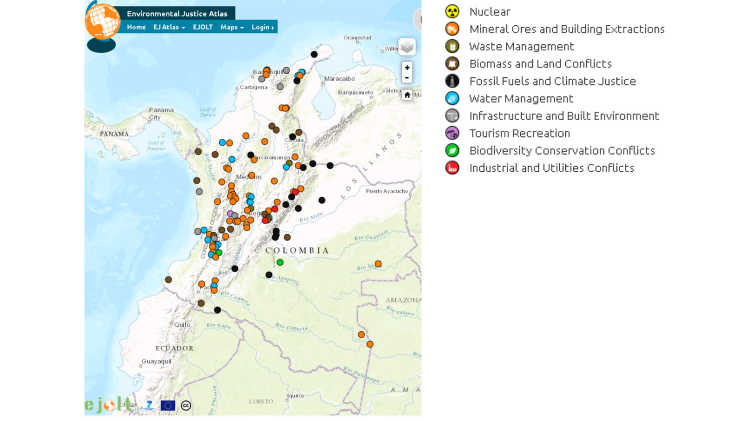
The increasing number of conflicts is associated with an exponential expansion of extractive activities in recent years, as a consequence of changes in the regulatory framework intended to transform the Colombian economy into a mining economy. This has been carried out primarily by facilitating foreign investments in extractive industries. Changes started in the 1980s under the Ernesto Samper government, which drafted a new mining code under the consultation of and with funding from the Canadian government, as Canadian corporations are major global players in mining operations. The mining code approved in 2001 under Alvaro Uribe drastically cut the royalties to be paid to the Colombian government as an incentive for foreign investment. During the eight years of Uribe’s government, there were even greater incentives for foreign investment through tax reductions or exemptions, labour flexibilisation, and the loosening of environmental standards (Pérez-Rincón 2014). The politics of “investment confidence” of Uribe’s government has been followed since 2010 by the “mining development engine” of Santos’s two terms. Not only has his government maintained the incentives for foreign investment in the extractive sector, but it also has a great deal of confidence in this sector providing at least some of the estimated USD 45 billion that it will cost to implement a guerrilla-demobilisation process.
The results of these policies are reflected in a significant expansion of new foreign direct investment (FDI), as shown in Figure 2, which since 2014 has only declined, as a result of decreasing international commodity prices.
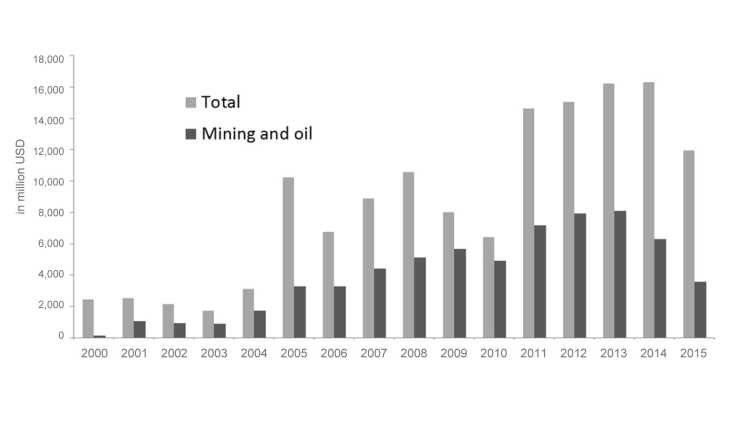
Colombia’s total exports grew from 6.72 billion USD in 1990 to 35.69 billion USD in 2015 (DANE 2016). Currently, 59 per cent of total exports correspond to oil and coal, while 5 per cent correspond to gold. However, the Colombian state, whose nominal income-tax rates and level of royalties are among the highest in Latin America, ranks among the lowest in terms of tax revenues per unit of value added by the mining and hydrocarbons sector. In the last two decades, for every dollar contributed to GDP by mining and hydrocarbons, the state received revenue of less than 16 cents (Rudas Lleras and Espitia Zamora 2013).
The favourable conditions for foreign investors in extractive activities have led to an increase in mining and oil titles and concessions. The number of mining titles granted in Colombia grew from 2,965 in 2002 to 9,131 in 2012. Of these titles, 61 per cent are for exploration and 39 per cent for extraction, and they cover a total of 4.4 per cent of the national territory. Similarly, the National Agency of Hydrocarbons, created in 2004 to promote oil exploration and extraction, has granted concessions of over 20.9 million hectares for exploration and has a further 54.5 million hectares available for prospective investors, including large offshore areas.
With such an expansion of the Colombian extractive frontier, it is difficult to avoid overlapping with territories of indigenous, black, and peasant communities, strategic areas for the provision of water and ecosystems of natural importance and cultural identity. Of the 72 environmental conflicts analysed by Pérez-Rincón (2014), 19 (26 per cent) are within areas of environmental conservation (e.g. national parks, protected areas, or páramos), with the same number of conflicts within ethnic territories. The large extractive projects in indigenous territories are the major contributors to 64 indigenous groups being at risk of extinction (ABColombia et al. 2012).
It has been recognised that extractive activities exacerbate physical violence in Colombia’s various territories in different ways. The presence of military forces is more pronounced in resource-rich areas; they are deployed to protect the infrastructure of extractive projects and to control social opposition to extraction. Extraction activities in areas such as coal, ferronickel, gold, and oil, as well as several agricultural products such as bananas and palm oil, are in many cases behind acts of violence perpetrated by illegal actors such as paramilitary forces with the intent of gaining or maintaining social and political control over territories (COHDES 2014).
To date, some six million people have been forcibly displaced and at least eight million hectares of land (some 14 per cent of Colombia’s territory) abandoned or forcibly appropriated as a result of the internal conflict. Some of those who have been forced to flee had been targeted as part of a deliberate policy to remove people from areas rich in natural resources. As early as 2000, UN rapporteur Francis Deng had identified displacement as a tool used not only by large landowners and narco-traffickers to acquire land, but also by private enterprises planning large-scale projects for the exploitation of natural resources and the implementation of large-scale development projects, in some cases concerning not only domestic economic interests but also the objectives of multinational corporations. It is thus not mere coincidence that the areas where guerrilla and paramilitary activity is most intense tend to be rich in natural resources. Amnesty International has documented numerous cases of community members having been threatened, forcibly displaced, or killed for their attempts to oppose outside mining interests, defend artisanal mining, and claim territorial rights (Amnesty International 2015).
This overview of the complex relationship between nature and society in Colombia points to one possible paradox of the coming decades in the aftermath of the peace agreement: as long as the government facilitates the further expansion of the extractive frontier, socio-environmental conflicts will intensify. This does pose a great threat, given that 41 of the 47 Colombian municipalities highly prioritised by the United Nations in the post–peace agreement stage have large areas of natur al parks and forest reserves, some of whose entire area falls into those categories. Additionally, mining titles have been granted in more than 80 per cent of the municipalities that have been recently (since 2010) affected by the conflict with the FARC, with some municipalities having more than 40 per cent of their territories granted in mining concessions (UNDP 2014).
Claiming Environmental Democratisation
In this context, communities around the country have organised resistance with multiple strategies and in some cases have been able to delay, suspend, or stop extractive projects. Some communities have activated participation mechanisms that were incorporated into the Constitution of 1991, in order to collectively decide whether they want to allow extractive activities into their territories or to protect water sources, soils, landscapes, and their traditional livelihoods.
The push for environmental democratisation started in 2004 when, as a result of two open hearings, the municipality of Cerrito in the Department of Santander suspended all mining activities on its territory through a bylaw. Since then, the community has also participated in discussions on territorial-planning schemes and has had direct verbal confrontations with guerrilla and paramilitary groups that have come to the area at various times stressing the desirability of exploiting coal in the páramo area. Moreover, in August 2010, the municipal council unanimously approved a popular normative initiative presented by the committee for the defence of the Almorzadero páramo. Under this initiative, mining is prohibited within páramos as they are considered fragile ecosystems essential to the water cycle.
Popular normative initiatives are a mechanism by which citizens promote the adoption of laws or regulations of lower rank. The proponents play an important role in the procedure, because they participate in all of the discussion sessions related to the initiative. According to the Electoral Observation Mission, between 1991 and 2012 four agreements came before municipal or district councils, of which only one was approved: the declaration of the Almorzadero páramo as an area excluded from mining.
Starting in 2007, a diverse group of activists supported by an international network for water justice proposed asking citizens whether they agreed on incorporating into the Constitution five principles related to water as a common good. This was done under the mechanism of a referendum through which people approve or reject a draft legal rule, or revoke one that is in place. The campaign for the referendum was initiated in February 2007 and completed in September 2008 with the acceptance of more than two million signatures. Yet, when the proposed text went to Congress for debate, the legislature modified or deleted many of its components, and the intent behind the original text was completely distorted. After a long struggle to restore the referendum’s manifesto to its original version, in May 2010 the low participation of chamber members did not allow the required half-plus-one majority to be reached. This defeat abruptly interrupted a process of more than two years in duration, arguably the largest social-mobilisation initiative the country had ever seen.
In 2010 a popular movement arising from Santander and Norte de Santander promoted the implementation of two popular consultations to protect the Berlin and Santurbán páramos. These páramos together provide water to more than two million inhabitants in 72 municipalities and are at the core of a dispute with the Canadian Eco Oro Minerals Corporation, the company formerly known as Grey Star, which had originally obtained the mining rights. This company plans to operate a gold mine and has already invested more than USD 150 million to that end, some of which was provided by international financial institutions. Until 2011 Grey Star had been planning an open-pit gold mine, but because of massive demonstrations, and given the Ministry of Environment’s refusal to grant a licence to the project in the Santurbán páramo, the renamed corporation is now planning to operate a tunnel mine. A constitutional judicial review declared that holding the popular consultation was feasible, though only for Norte de Santander, and scheduled it for October 2011. However, despite all requirements having been met, the National Electoral Commission and the National Civil Registry still did not implement the procedure. They argued that the electoral kits for the local elections had already been delivered without the consultation ballots, and that it would thus be logistically impossible to arrange for the extra ballot cards to be sent (MOE 2012).
In 2013 two popular consultations took place in the municipalities of Piedras and Tauramena expressing an overwhelming opposition to extractive projects. In July 2013 the municipality of Piedras, Tolima – whose economy is based on agriculture and livestock – conducted the first popular consultation targeting an extractive project to protect the municipality and the Opia River from the development of a mining district which was envisaged to be one of the ten largest open-pit mines in the world, a project called La Colosa. It was to be operated by AngloGold Ashanti (AGA), the world’s third-largest gold producer. The alliance between peasants, large landowners, and municipal institutions together with the support of environmental committees, students, and legal advisors activated the popular consultation mechanism.
Five and a half months later, in December 2013 in the town of Tauramena, Casanare, a second popular consultation was held in response to plans by the Colombian company Ecopetrol to implement the seismic exploration project Odyssey 3D in six municipalities in Casanare, with Tauramena representing 52 per cent of the affected area. The community was concerned about the possible effects that seismic exploration could have on water sources.
The Piedras and Tauramena consultations were validated as they both exceeded the mandatory minimum requirement that one-third of the total registered-voter population in fact cast a vote in the consultation; the citizens’ decision to protect the territories in question was almost unanimous. These two bottom-up movements of environmental democratisation generated a multifaceted reaction on the part of the national government, which after the successful consultation in Piedras tried to prevent the consultation in Tauramena.
Following the lead of Piedras, the municipality of Cajamarca – where the gold reserves of La Colosa are located – has been discussing the possibility of calling a popular consultation through public hearings amidst fierce opposition from the mining company. In August 2016, with continued social mobilisation, the municipal council approved the popular consultation whose question will be evaluated by the administrative tribunal of Tolima. In February 2016 the city council of Ibague, the capital city of the Department of Tolima, located in La Colosa’s area of influence, approved the implementation of a popular consultation promoted by local environmental organisations. After months of significant political pressure on the administrative tribunal of Tolima, the consultation was approved; it is scheduled for October 2016.
Several other attempts to carry out popular consultations at the municipal level were blocked. For example, in the municipalities of Pueblorrico and Pijao, the consultations had already been endorsed by mayors and city councils. However, the administrative courts of Antioquia and Quindío blocked consultations in their respective municipalities, arguing the latter’s lack of competence. Pueblorrico opted for autonomous popular legislative instruments such as popular mandates, which, so far, have kept mining activities off of municipal territory; Pijao filed a tutela which was rejected twice by the State Council and subsequently selected for review by the Constitutional Court, though no ruling has yet been made.
However, not all state institutions opposed the consultations. The State Council, for example, has suspended governmental decrees that were intended to undermine the autonomy of municipalities to decide how to use their own territories (Decree 934 of 2013) or to participate in a just and informed manner (Decree 2691 of 2014). Furthermore, the Ministry of the Interior drafted Law 1757 in 2015, which facilitates the use of participation mechanisms by skipping the requirement for approval by the city council if a community can collect the signatures of 20 per cent or more of the electorate.
More recently, and in line with the State Council, in May 2016 the Constitutional Court ruled on the unconstitutionality of Article 37 of the mining code, which prevented territorial authorities from prohibiting mining. In June 2016 the Constitutional Court made yet another significant decision, this time responding to a tutela for the protection of ethnic minorities’ rights to consultation and to territories that were being violated by the establishment of so-called “strategic mining areas.” In February 2016 the Constitutional Court also ruled in favour of the protection of the fundamental right to water by declaring mining activities in páramos unconstitutional.
Environmental Democratisation, Environmental Peace, and Nature–Society Relations
These developments reveal an environmental democratisation already in motion in extractive frontiers, the appropriation of the right to participation by affected communities, and a growing societal aspiration towards environmental democratisation. The activities of local movements in extractive frontiers resonated in the wider regions, inspiring other local movements and even, in the case of the water referendum, a national mobilisation. The state has used strategies to block the mechanisms, sometimes successfully, but it has not been able to defeat the overwhelming demand of communities to have access to meaningful and consequential ways of participating in decisions affecting water, territories, and livelihoods.
The social movements for environmental democratisation are disseminating several messages. One clear message for the near future is that there will not be peace in the territories without environmental peace. Opening up the extractive frontiers further to heighten the social metabolism at the expense of local livelihoods, landscapes, water sources, and rural identities will transform but not reduce the conflict. Building roads, waterways, and large hydroelectric dams in order to facilitate the extraction of minerals, fuels, and biomass from territories that have had limited exposure to the state means at least two things: first, it means disregarding historical factors that have fuelled the internal conflict; second, it means continuing along the unsustainable path of extractive development, with its destructive capacity and its patterns of injustice and violence vis-à-vis individuals, communities, and nature.
The concession of mining and oil exploration titles in fragile ecosystems in protected areas, water-scarce regions, and territories of ethnic and peasant communities – which characterises the municipalities that have been prioritised for the post-war era – makes it absolutely necessary to develop an entirely new approach to development in these territories. The state’s vision of doubling coal production, quadrupling gold exports, and tripling the mining area between 2011 and 2021 (ABColombia et al. 2015) clearly disregards local and global socio-environmental concerns and ignores the contribution of extractive activities to the internal conflict.
In the context of the peace process, new proposals point towards economic alternatives around food production, eco-tourism, bioprospecting, and payment for environmental services (UNDP 2014). But any alternative should be vetted and well considered, lest it become just a different way of appropriating nature, as some of these proposals already fall within the logic of investment opportunities for global capital accumulation, financialisation, and rent seeking.
The activation of democratic mechanisms for the environment is also a call to pay attention to the current conjuncture of pressing global trends. These trends include climate change, with its effects on food production and health, and the growing number of people for whom the capitalist system will not keep its promise of inclusion through productive and fairly compensated labour. In light of this, for six million Colombians who were displaced to the margins of urban areas, there is an urgent need for restitution of the usurped land. This restitution needs to focus on legal titles to land and the recognition of water as a common good that is integral to territories and defines the identities of ethnic and peasant communities. Small-scale, labour-intensive, and requiring little energy use, peasant agriculture is significantly more sustainable than large-scale commercial agriculture, one of the largest contributors to greenhouse gases and climate change.
It has been argued that the current ecological crisis is a result of a global system based on the separation of society from nature. The view of nature as an external object at the service of society has facilitated its appropriation, commodification, and exhaustion. The frontier is explicit in the ownership of the subsoil by developmentalist nation-states. By defining minerals and fuels as strategic resources for the benefit of all citizens, nation-states become intermediaries between society and nature in deciding who, where, and how these resources are extracted. The environmental democratisation movement represents a strategy to transcend this nature–society divide. By abandoning the “society plus nature” binary model, the questions asked in consultations, referendums, and popular initiatives in Colombia surround how we want to be collectively configured in the web of life (Moore 2015). With the unprecedented global inequality of cultural, political, and economic power within and across geographical scales, these fundamental forms of democratisation are imperative.
Allowing, defending, and encouraging societal participation in environmental and territorial decision making in the context of the transition to peace represents a transformation of environmental conflicts into scenarios of democratisation. The use of participation mechanisms rejects the language that tends to depoliticise and convert political issues into technical and scientific decisions (Swyngedouw 2010). The last three rulings of the Constitutional Court, putting a halt to the unilateral decision of the central government regarding mining activities, could be interpreted as an attempt to put the brakes on the economic model based on extractive activities. These rulings can also be regarded as the response of the Constitutional Court to the broad aspiration – emanating from a wide range of communities – to recover political spaces of debate and decision making. This is exactly what a transition to peace entails.
Environmental democratisation is a process already in motion as a response from communities to the violence that has been fuelled by extractivism. This process, together with other mechanisms of social participation in decision making at the local level, highlights the relevance of environmental issues and is indispensable for environmental justice and peace in Colombia.
Footnotes
References
ABColombia – CAFOD, Christian Aid, OXFAM GB, SCIAF, Trócaire (2012), Giving It Away: The Consequences of an Unsustainable Mining Policy in Colombia, www.caritas.org/2012/11/giving-it-away-the-consequences-of-an-unsustainable-mining-policy-in-colombia/ (30 June 2016).
Amnesty International (2015), Colombia: Restoring the Land, Securing the Peace: Indigenous and Afro-descendants Territorial Rights, https://www.amnestyusa.org/sites/default/files/colombia_land_-_briefing_eng.pdf (30 June 2016).
Banco de la República (2016), Inversión Extranjera Directa, www.banrep.gov.co/inversion-directa (30 June 2016).
Centro de Investigación y Educación Popular (CINEP) (2012), Minería, conflictos sociales y violación de derechos humanos en Colombia, Bogota: CINEP.
Consultoría Para Los Derechos Humanos y el Desplazamiento (COHDES) (2014), El Desplazamiento Forzado y la Imperiosa Necesidad de la Paz, in: Boletín de la Consultoría para los Derechos Humanos y el Desplazamiento, 82.
Departamento Administrativo Nacional de Estadística (DANE) (2016) (30 June 2016).
Environmental Justice Atlas (EJATLAS) (2016), https://ejatlas.org/country/colombia (30 June 2016).
Global Witness (2016), On Dangerous Grounds, report, 20 June, www.globalwitness.org/en/reports/dangerous-ground/ (30 June 2016).
Martinez-Alier, Joan (2009), Social Metabolism, Ecological Distribution Conflicts, and Languages of Valuation, in: Capitalism Nature Socialism, 20, 1, 58–87.
Martínez-Alier, Joan, and Mariana Walter (2016), Social Metabolism and Conflicts over Extractivism, in: Fábio de Castro, Barbara Hogenboom, and Michiel Baud (eds), Environmental Governance in Latin America, London: Palgrave Macmillan, 58–85.
Martinez-Alier, Joan, Giorgios Kallis, Sandra Veuthey, Mariana Walter, and Leah Temper (2010), Social Metabolism, Ecological Distribution Conflicts, and Valuation Languages, in: Ecological Economics, 70, 2, 153–158.
Misión de Observación Electoral (MOE) (2012), Mecanismos de participación ciudadana en Colombia, 20 años de ilusiones, Bogota.
Moore, Jason W. (2015), Capitalism in the Web of Life: Ecology and the Accumulation of Capital, New York: Verso.
Muradian, Roldan, Mariana Walter, and Joan Martinez-Alier (2012), Hegemonic Transitions and Global Shifts in Social Metabolism: Implications for Resource-Rich Countries, Introduction to the Special Section, in: Global Environmental Change, 22, 559–567.
Pérez-Rincón, Mario Alejandro (2014), Conflictos Ambientales en Colombia: Inventario, Caracterización y Análisis, Cali: Universidad del Valle, CINARA, EJOLT.
Rudas Lleras, Guillermo, and Jorge Enrique Espitia Zamora (2013), Participación del Estado y la sociedad en la renta minera, in: Luis Jorge Garay Salamanca (ed.), Minería en Colombia, Fundamentos para superar el modelo extractivista, Bogota: Contraloría General de la República, 125–174.
Swyngedouw, Erik (2010), Apocalypse Forever? Post-Political Populism and the Spectre of Climate Change, in: Theory, Culture & Society, 27, 2–3, 213–232.
United National Development Programme (UNDP) (2014), Consideraciones ambientales para la construcción de una paz territorial estable, duradera y sostenible en Colombia (30 June 2016).
General Editor GIGA Focus
Editor GIGA Focus Latin America
Regional Institutes
Research Programmes
How to cite this article
Roa, Cecilia (2016), Environmental Democratisation in Post-War Colombia, GIGA Focus Latin America, 5, Hamburg: German Institute for Global and Area Studies (GIGA), http://nbn-resolving.de/urn:nbn:de:0168-ssoar-48184-7
Imprint
The GIGA Focus is an Open Access publication and can be read on the Internet and downloaded free of charge at www.giga-hamburg.de/en/publications/giga-focus. According to the conditions of the Creative-Commons license Attribution-No Derivative Works 3.0, this publication may be freely duplicated, circulated, and made accessible to the public. The particular conditions include the correct indication of the initial publication as GIGA Focus and no changes in or abbreviation of texts.
The German Institute for Global and Area Studies (GIGA) – Leibniz-Institut für Globale und Regionale Studien in Hamburg publishes the Focus series on Africa, Asia, Latin America, the Middle East and global issues. The GIGA Focus is edited and published by the GIGA. The views and opinions expressed are solely those of the authors and do not necessarily reflect those of the institute. Authors alone are responsible for the content of their articles. GIGA and the authors cannot be held liable for any errors and omissions, or for any consequences arising from the use of the information provided.



